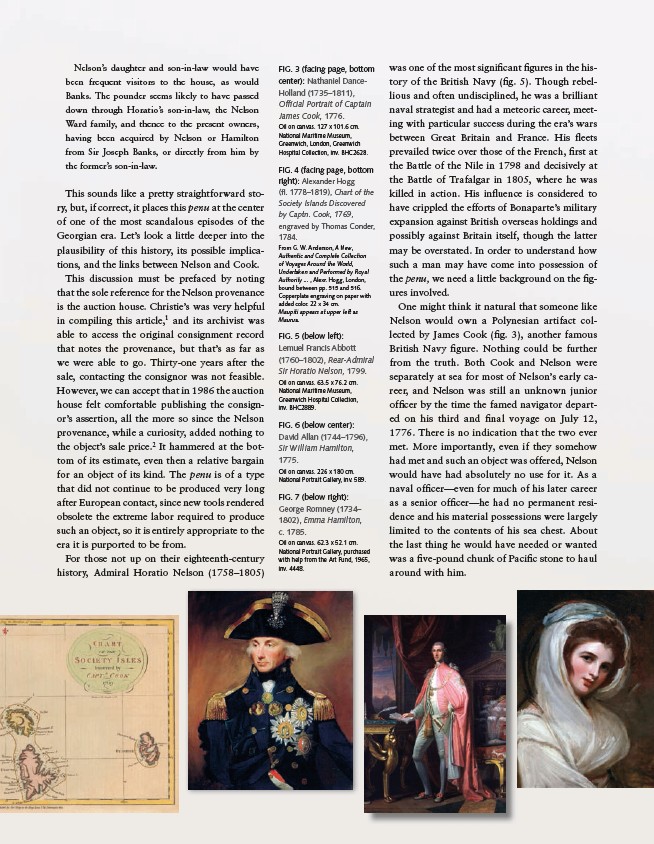
125
Nelson’s daughter and son-in-law would have
been frequent visitors to the house, as would
Banks. The pounder seems likely to have passed
down through Horatio’s son-in-law, the Nelson
Ward family, and thence to the present owners,
having been acquired by Nelson or Hamilton
from Sir Joseph Banks, or directly from him by
the former’s son-in-law.
This sounds like a pretty straightforward story,
but, if correct, it places this penu at the center
of one of the most scandalous episodes of the
Georgian era. Let’s look a little deeper into the
plausibility of this history, its possible implications,
and the links between Nelson and Cook.
This discussion must be prefaced by noting
that the sole reference for the Nelson provenance
is the auction house. Christie’s was very helpful
in compiling this article,1 and its archivist was
able to access the original consignment record
that notes the provenance, but that’s as far as
we were able to go. Thirty-one years after the
sale, contacting the consignor was not feasible.
However, we can accept that in 1986 the auction
house felt comfortable publishing the consignor’s
assertion, all the more so since the Nelson
provenance, while a curiosity, added nothing to
the object’s sale price.2 It hammered at the bottom
of its estimate, even then a relative bargain
for an object of its kind. The penu is of a type
that did not continue to be produced very long
after European contact, since new tools rendered
obsolete the extreme labor required to produce
such an object, so it is entirely appropriate to the
era it is purported to be from.
For those not up on their eighteenth-century
history, Admiral Horatio Nelson (1758–1805)
was one of the most signifi cant fi gures in the history
of the British Navy (fi g. 5). Though rebellious
and often undisciplined, he was a brilliant
naval strategist and had a meteoric career, meeting
with particular success during the era’s wars
between Great Britain and France. His fl eets
prevailed twice over those of the French, fi rst at
the Battle of the Nile in 1798 and decisively at
the Battle of Trafalgar in 1805, where he was
killed in action. His infl uence is considered to
have crippled the efforts of Bonaparte’s military
expansion against British overseas holdings and
possibly against Britain itself, though the latter
may be overstated. In order to understand how
such a man may have come into possession of
the penu, we need a little background on the fi gures
involved.
One might think it natural that someone like
Nelson would own a Polynesian artifact collected
by James Cook (fi g. 3), another famous
British Navy fi gure. Nothing could be further
from the truth. Both Cook and Nelson were
separately at sea for most of Nelson’s early career,
and Nelson was still an unknown junior
offi cer by the time the famed navigator departed
on his third and fi nal voyage on July 12,
1776. There is no indication that the two ever
met. More importantly, even if they somehow
had met and such an object was offered, Nelson
would have had absolutely no use for it. As a
naval offi cer—even for much of his later career
as a senior offi cer—he had no permanent residence
and his material possessions were largely
limited to the contents of his sea chest. About
the last thing he would have needed or wanted
was a fi ve-pound chunk of Pacifi c stone to haul
around with him.
FIG. 3 (facing page, bottom
center): Nathaniel Dance-
Holland (1735–1811),
Offi cial Portrait of Captain
James Cook, 1776.
Oil on canvas. 127 x 101.6 cm.
National Maritime Museum,
Greenwich, London, Greenwich
Hospital Collection, inv. BHC2628.
FIG. 4 (facing page, bottom
right): Alexander Hogg
(fl . 1778–1819), Chart of the
Society Islands Discovered
by Captn. Cook, 1769,
engraved by Thomas Conder,
1784.
From G. W. Anderson, A New,
Authentic and Complete Collection
of Voyages Around the World,
Undertaken and Performed by Royal
Authority ... , Alexr. Hogg, London,
bound between pp. 515 and 516.
Copperplate engraving on paper with
added color. 22 x 34 cm.
Maupiti appears at upper left as
Maurua.
FIG. 5 (below left):
Lemuel Francis Abbott
(1760–1802), Rear-Admiral
Sir Horatio Nelson, 1799.
Oil on canvas. 63.5 x 76.2 cm.
National Maritime Museum,
Greenwich Hospital Collection,
inv. BHC2889.
FIG. 6 (below center):
David Allan (1744–1796),
Sir William Hamilton,
1775.
Oil on canvas. 226 x 180 cm.
National Portrait Gallery, inv. 589.
FIG. 7 (below right):
George Romney (1734–
1802), Emma Hamilton,
c. 1785.
Oil on canvas. 62.3 x 52.1 cm.
National Portrait Gallery, purchased
with help from the Art Fund, 1965,
inv. 4448.